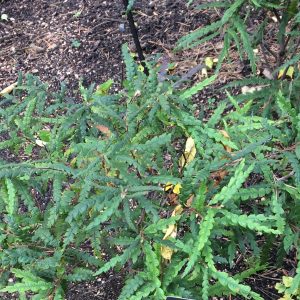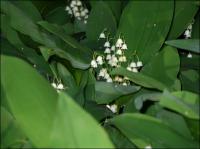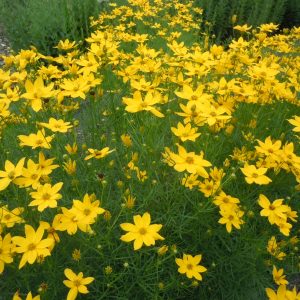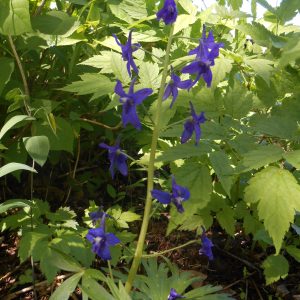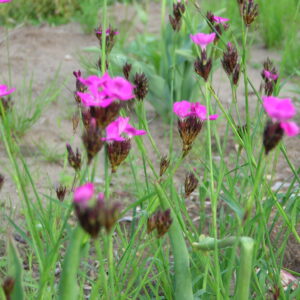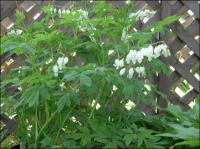Deer Resistant Plants
Showing 41–48 of 155 results
-
Cleome serrulata Rocky Mountain Beeweed, Spiderflower, Stinkweed Reseeding annual
Blooming all summer dozens of rose to lilac-colored flowers bunch together at the top of the 3-4” tall stem seemingly one soft-ball sized flower. Thread-thin stamens protrude above the flowers, each flower bearing six stamens, 72, for example, if the cluster contains a mere dozen individual flowers earning it the nickname spider flower. Short leaves grow the length of plant stems, from bottom to top, bare of flowers. A trio of leaflets to each leaf, one as a leader with two sidekicks.
OUT OF STOCK – EMAIL FOR AVAILABILITY
Blooming all summer dozens of rose to lilac-colored flowers bunch together at the top of the 3-4” tall stem seemingly one soft-ball sized flower. Thread-thin stamens protrude above the flowers, each flower bearing six stamens, 72, for example, if the cluster contains a mere dozen individual flowers earning it the nickname spider flower. Short leaves grow the length of plant stems, from bottom to top, bare of flowers. A trio of leaflets to each leaf, one as a leader with two sidekicks.
Size: 4' x 9"
Care: sun in moist-well drained to dry soil, drought tolerant
Native: Minnesota west to the Pacific, south to Arizona and New Mexico and all in between.
Wildlife Value: : So many flowers, each with nectar and a hoard of stamens each holding pollen in a soft-ball sized object makes this a mecca for pollinators of all sorts, numerous bee species, wasps and several butterflies. When it’s done flowering birds eat its seeds. Its skunk-like odor (Stinkweed) has one advantage – it keeps the deer away.An ancient, pre-historic plant, Natives including Lakota, Zuni, Tewa, Navajo, and Pueblo found many uses for this Cleome. Some ate shoots, leaves, seeds or flowers, cooked them, or ate them raw alone or together with other food. Tewa grew this with corn, beans and squash to attract pollinators to pollinate the food plants. Infusions treated fever, and stomach aches. A poultice treated sore eyes. Lakota used this and a shrub to trap bison. Navajo color rugs with a yellow-green dye they make from Cleome. Pueblo Indians concentrate Cleome to make a thick, black paste to decorate baskets and pottery. Meriwether Lewis collected three of these two on the way west and one homebound traveling east.
-
Comptonia peregrina Sweet Fern Z 2-6 SHRUB
Grown for it’s fern like leaves, this small shrub flowers in spring with insignificant yellow flowers followed by brown nutlets. Foliage is fragrant when crushed.
Grown for its fern like leaves, this small shrub flowers in spring with insignificant yellow flowers followed by brown nutlets. Foliage is fragrant when crushed.
LIMITED QUANTITES AVAILABLE. ONE PER CUSTOMER PLEASE.
Size: 2-5’ x 4’ spreading
Care: sun to part shade in moist, well-drained to well-drained soil. Prefers acidic, but will grow in other types of soil as well. Drought and salt tolerant.
Native: Eastern North America, Wisconsin native
Wildlife Value: Attracts bees, butterflies, & birds. Larval host plant for many moths, including Io moth, several Sphinx moth species, and the Anise Swallowtail butterfly. Deer resistant. Nitrogen fixer.Genus name honors Henry Compton (1632-1713), Bishop of London and patron of botany. Many Native Americans (Algonquin, Cherokee, Chippewa, Delaware, Menominee, Potawatomi) used this plant for a wide variety of purposes: crushed leaves inhaled for headache. Leaf infusions for round worms, fevers, beverage, blood purifier, blisters, clear mucus from lungs, bladder inflammation, rash from poison ivy, swelling, flux, stomach cramps, itch. Fragrant leaves- burned or crushed for incense in ceremony, perfume; decoction for childbirth, tonic. Other: sprinkle on medicine to poison enemy, prevent blueberries from spoiling, leaves in fire to make smudge to ward off mosquitoes. Oneida made a tea.
Collected for botany before 1753. Grown at America’s 1st botanic garden, Elgin Botanic Garden 1811.**LISTED AS OUT OF STOCK BECAUSE WE DO NOT SHIP THIS ITEM. IT IS AVAILABLE FOR PURCHASE AT OUR RETAIL LOCATION.
-
Convallaria majalis Lily of the Valley Z 2-7
Classic - dainty alabaster white bells perfume the air in spring. Frangrance unmistakable.
Classic – dainty alabaster bells perfume the air in spring. Fragrance unmistakeable.
Can not ship to: Maryland
Size: 9" x Spreading.
Care: part shade to shade in moist or moist well-drained soil.
Native: north temperate zones in the world.Convallaria is Latin means “valley.” Majalis means “May flowering.” Lily of the valley has been cultivated since at least 1000 B.C. The Norse goddess of dawn adopted it as her special flower. According to legend the plant first appeared at the spot where St. Leonard shed blood while conquering the dragons. Grown in the garden of Johann Konrad von Gemmingen prince bishop of Eichstätt in Bavaria, c. 1600. 17th century herbalists used Lily of the Valley to improve memory and strengthen the heartbeat. Robert Louis Stevenson reported medicinal uses in Kidnapped: “for sprains, rub it in; and for the cholic, a greate spooneful in the hour.” Grown by Jefferson at Monticello. Pressed specimen in Emily Dickinson’s herbarium.
-
Coreopsis verticillata Thread leafed tickseed Z 4-9
All summer into fall, free-blooming non-stop - yolk yellow daisies of 8 narrow spoon-shaped petals with a color matching center each atop a wiry stem. Cut back half-way to promote reblooming in fall.
All summer into fall, free-blooming non-stop – yolk yellow daisies of 8 narrow spoon-shaped petals with a color matching center each atop a wiry stem. Cut back half-way to promote reblooming in fall.
Size: 24" x 18" spreading
Care: Sun to part shade well-drained to moist well-drained soil, drought tolerant
Native: S.E. U.S.
Wildlife Value: attracts butterflies, Deer resistantExported from its native America to England in 1759. Used to dye cloth red.
-
Delphinium tricorne Dwarf larkspur, Spring larkspur Z 4-8
Spring ephemeral of blue delphinium elf-cap spikes. Substitute these for tulips, a favorite food of deer and rabbits
OUT OF STOCK – Available to order in Spring only
Spring ephemeral of blue delphinium elf-cap spikes. Substitute these for tulips, a favorite food of deer and rabbits
Size: 18-24” – 6-9”
Care: sun to shade in moist well-drained to moist soil
Native: Pennsylvania to Iowa, south to Alabama and Oklahoma and states in between
Wildlife Value: food for hummingbirds and butterflies; deer & rabbit resistant.Collected by André Michaux c. 1800. Cherokee used this for heart ailments and reported that it makes cows intoxicated and they die. The name tricorne comes from the 3-cornered shape of its seeds, like the shape of colonial hats with brims turned up on three sides. This is breathtakingly beautiful but slow to grow. It is also an ephemeral and dies back after going to seed so mark it or have a good memory where it is so you don’t dig into it planting something else. It comes back in spring.
-
Dianthus carthusianorum Clusterhead PinkDianthus carthusianorum Carthusian pink, Clusterhead pink Z 5-9
Deep reddish pink flowers atop wiry stems from June until frost
Rosy carmine pink flowers atop wiry stems from June until frost
Size: 16" x 8"
Care: sun in moist well-drained soil.
Native: Central and southern Europe
Wildlife Value: attracts hummingbirds. Deer resistant.The common name “pink” is from “pinct” referring to the jagged edge of the petals. The word “pink” referring to the color, came from the fact that most of the Dianthus are pink. This species may have come into gardens with the Carthusian monks in the 1100’s.
-
Dicentra spectablis Alba syn Lamprocapnos spectabilis White bleeding heart Z 3-9
Dangling alabaster, heart shaped blossoms
May – June Legendary dangling alabaster, heart shaped blossoms. One of the best.
Size: 36" x 18"
Care: Part shade to shade in moist well-drained soil.
Native: JapanDicentra derived from Greek dis meaning “two” and kentros meaning “spurs.” The white form in gardens in the West 1877.
-
Dicentra spectablis syn Lamprocapnos spectabilis Bleeding Heart Z 3-9
May - June legendary dangling dark pink heart shaped blossoms. One of the best.
OUT OF STOCK
From May through June legendary dangling, dark pink heart-shaped blossoms. One of the best.
Size: 36" x 18"
Care: Part shade to shade, moist well-drained soil.
Native: Japan
Awards: Royal Horticultural Society Award of MeritDicentra derived from Greek dis meaning “two” and kentros meaning “spurs” because the flowers have two spurs. Spectabilis means “worthy of notice.” The Bleeding heart was a favorite garden plant in China for centuries before its discovery by Europeans. Introduced to the West in 1846 after Robert Fortune found it growing on the Island of Chusan and sent it to the Horticultural Society of London. It became an immediate sensation in England. By 1866 the Bleeding heart was available in America.
**LISTED AS OUT OF STOCK BECAUSE WE DO NOT SHIP THIS ITEM. IT IS AVAILABLE FOR PURCHASE AT OUR RETAIL LOCATION.


